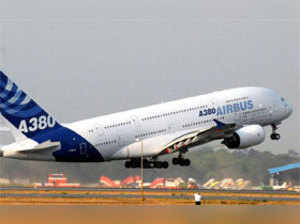 Agencies
AgenciesNew Delhi: Airbus on Monday revealed concepts of new hydrogen-powered zero-emission commercial aircraft that could enter service by 2035. "The three concepts - all codenamed "ZEROe" - for a first climate neutral zero-emission commercial aircraft include a turbofan design (with capacity of 120-200 passengers) with a range of 2,000+ nautical miles," said a press release by the aircraft manufacturer.
The turbofan design would be capable of operating trans-continentally and would be powered by a modified gas-turbine engine running on hydrogen, rather than jet fuel, through combustion, it stated.
At a press briefing, Airbus India president Remi Maillard told reporters that, "we believe that hydrogen will increasingly become more cost-competitive in the future, because other industries, and not just aviation, will move towards hydrogen power sources".
The second concept is a turboprop design that can carry up to 100 passengers and is powered by hydrogen combustion in modified gas-turbine engines, the release stated.
The turboprop design would be capable of travelling more than 1,000 nautical miles, making it a perfect option for short-haul trips, it mentioned.
Malliard said, "Obviously, many challenges remain, namely the availability of hydrogen, decarbonisation of the production of hydrogen, and the airworthiness certification of a hydrogen powered aircraft."
He said airports, for instance, will require significant hydrogen transport and refuelling infrastructure to meet the needs of day-to-day operations.
"We will need to convert our oil and gas network as well to make them suitable for hydrogen," Malliard said.
"So, it is the beginning of a journey and we are committed to this ambition," he said.
The third concept is a "blended-wing body" design, which can carry up to 200 passengers. In this design, the wings merge with the main body of the aircraft. It will be able to operate trans-continentally, the release stated.
These three concepts for the "world's first zero-emission commercial aircraft" could enter service by 2035, it stated.
"All of these concepts rely on hydrogen as a primary power source - an option which Airbus believes holds exceptional promise as a clean aviation fuel and is likely to be a solution for aerospace and many other industries to meet their climate-neutral targets," said the release.
The turbofan design would be capable of operating trans-continentally and would be powered by a modified gas-turbine engine running on hydrogen, rather than jet fuel, through combustion, it stated.
At a press briefing, Airbus India president Remi Maillard told reporters that, "we believe that hydrogen will increasingly become more cost-competitive in the future, because other industries, and not just aviation, will move towards hydrogen power sources".
The second concept is a turboprop design that can carry up to 100 passengers and is powered by hydrogen combustion in modified gas-turbine engines, the release stated.
The turboprop design would be capable of travelling more than 1,000 nautical miles, making it a perfect option for short-haul trips, it mentioned.
Malliard said, "Obviously, many challenges remain, namely the availability of hydrogen, decarbonisation of the production of hydrogen, and the airworthiness certification of a hydrogen powered aircraft."
He said airports, for instance, will require significant hydrogen transport and refuelling infrastructure to meet the needs of day-to-day operations.
"We will need to convert our oil and gas network as well to make them suitable for hydrogen," Malliard said.
"So, it is the beginning of a journey and we are committed to this ambition," he said.
The third concept is a "blended-wing body" design, which can carry up to 200 passengers. In this design, the wings merge with the main body of the aircraft. It will be able to operate trans-continentally, the release stated.
These three concepts for the "world's first zero-emission commercial aircraft" could enter service by 2035, it stated.
"All of these concepts rely on hydrogen as a primary power source - an option which Airbus believes holds exceptional promise as a clean aviation fuel and is likely to be a solution for aerospace and many other industries to meet their climate-neutral targets," said the release.
(Catch all the Business News, Breaking News, Sikkim Election Results News,Arunachal Pradesh Election Result News, Election Results News Events and Latest News Updates on The Economic Times.)
Subscribe to The Economic Times Prime and read the ET ePaper online.
(Catch all the Business News, Breaking News, Sikkim Election Results News,Arunachal Pradesh Election Result News, Election Results News Events and Latest News Updates on The Economic Times.)
Subscribe to The Economic Times Prime and read the ET ePaper online.





